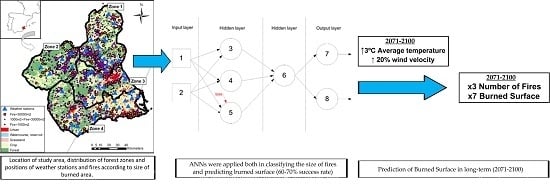Evolution of Burned Area in Forest Fires under Climate Change Conditions in Southern Spain Using ANN
Abstract
1. Introduction
2. Materials and Methods
2.1. Data
2.1.1. Study Area
2.1.2. Wildfire Records
2.1.3. Weather Stations
2.1.4. Fire Weather Indices
2.2. Methods
2.2.1. Database
2.2.2. Cluster Analysis
2.2.3. Artificial Neural Network (ANN)
2.2.4. ANN Classification Performance Evaluation Methods
- Classification accuracy
- Sensitivity and specificity
- Confusion matrix
- k-fold cross-validation
2.2.5. ANN Burned Area Prediction Metrics
3. Results
3.1. Climate Change
3.2. Classification of Fires
3.3. Burned Area Prediction under Climate Change
4. Discussion
5. Conclusions
Author Contributions
Funding
Acknowledgments
Conflicts of Interest
References
- Molina, D.; Blanco, J.; Galan, M.; Pous, E.; García Jurado, J.; García Jurado, D. Incendios Forestales: Fundamentos, Lecciones Aprendidas y Retos de Futuro; Ed. AIFEMA: Granada, Spain, 2009. [Google Scholar]
- Moritz, M. Spatiotemporal analysis of controls on shrubland and fire regimes: Age dependency and fire hazard. Ecology 2003, 84, 351–361. [Google Scholar] [CrossRef]
- Minnich, R.A.; Bahre, C.J. Wildland fire and chaparral succession along the california-baja california boundary. Int. J. Wildland Fire 1995, 5, 13–24. [Google Scholar] [CrossRef]
- Hardy, C. Wildland fire hazard and risk: Problems, definitions and context. For. Ecol. Manag. 2005, 211, 73–82. [Google Scholar] [CrossRef]
- Analitis, A.; Georgiadis, I.; Katsouyanni, K. Forest fires are associated with elevated mortality in a dense urban setting. Occup. Environ. Med. 2012, 9, 158–162. [Google Scholar] [CrossRef] [PubMed]
- Jayachandran, S. Air quality and early-life mortality: Evidence from Indonesia’s wildfires. J. Hum. Resour. 2009, 44, 916–954. [Google Scholar] [CrossRef][Green Version]
- Vedal, S.; Dutton, S.J. Wildfire air pollution and daily mortality in a large urban area. Environ. Res. 2006, 102, 29–35. [Google Scholar] [CrossRef] [PubMed]
- Bowman, D.M.J.S.; Johnston, F.H. Wildfire smoke, fire management, and human health. EcoHealth 2005, 2, 76–80. [Google Scholar] [CrossRef]
- Reed, W.J.; McKelvey, K.S. Power-law behaviour and parametric models for the size-distribution of forest fires. Ecol. Model. 2002, 150, 239–354. [Google Scholar] [CrossRef]
- Özbayoğlu, A.M.; Bozer, R. Estimation of the Burned Area in Forest Fires Using Computational Intelligence Techniques. Procedia Comput. Sci. 2012, 12, 282–287. [Google Scholar] [CrossRef]
- Vélez, R. Causes of fires in the Mediterranean basin. EFI Proc. 2002, 45, 35–42. [Google Scholar]
- San-Miguel-Ayanz, J.; Pereira, J.; Boca, R.; Strobl, P.; Kucera, J.; Pekkarinen, A. Forest fires in the European Mediterranean region: Mapping and analysis of burned areas. In Earth Observation of Wildland Fires in Mediterranean Ecosystems; Chuvieco, E., Ed.; Springer: Berlin/Heidelberg, Germany, 2009; pp. 189–204. [Google Scholar]
- San-Miguel-Ayanz, J.; Schulte, E.; Schmuck, G.; Camia, A.; Strobl, P.; Liberta, G.; Giovando, C.; Boca, R.; Sedano, F.; Kempeneers, P.; et al. Comprehensive monitoring of wildfires in Europe: The European Forest Fire Information System (EFFIS). In Approaches to Managing Disaster–Assessing Hazards, Emergencies and Disaster Impacts; Tiefenbacher, J., Ed.; In-Tech Publishers: Texas State University, San Marcos, TX, USA, 2012. [Google Scholar]
- San-Miguel-Ayanz, J.; Moreno, J.; Camia, A. Analysis of large fires in European Mediterranean landscapes: Lessons learned and perspectives. For. Ecol. Manag. 2013, 294, 11–22. [Google Scholar] [CrossRef]
- Countryman, C.M. The Fire Environment Concept; U.S. Department of Agriculture Forest Service Pacific Southwest Forest and Range Experiment Station: Berkeley, CA, USA, 1972; Volume 21.
- Pyne, S.J.; Andrews, P.A.; Laven, R.D. Introduction to Wildland Fire; Wiley: New York, NY, USA, 1996; p. 769. [Google Scholar]
- Moritz, M.A.; Morais, M.E.; Summerell, L.A.; Carlson, J.M.; Doyle, J. Wildfires, complexity, and highly optimized tolerance. Proc. Natl. Acad. Sci. USA 2005, 102, 17912–17917. [Google Scholar] [CrossRef] [PubMed]
- Johnson, E.A. Fire and Vegetation Dynamics: Studies from the North American Boreal Forest; Cambridge University Press: Cambridge, UK, 1992. [Google Scholar]
- Swetnam, T.W. Fire history and climate change in giant sequoia groves. Science 1993, 262, 885–889. [Google Scholar] [CrossRef] [PubMed]
- Flannigan, M.D.; Wotton, B.M. Climate, weather and area burned. In Forest Fires: Behavior & Ecological Effects; Johnson, E.A., Miyanishi, K., Eds.; Academic Press: University of Calgary, Calgary, AL, Canada, 2000; pp. 335–357. [Google Scholar]
- DGCN. Los Incendios Forestales en España. Decenio 1996–2005; Dirección General de Conservación de la Naturaleza. Ministerio de Medio Ambiente: Madrid, Spain, 2006. [Google Scholar]
- Niklasson, M.; Granstrom, A. Numbers and Sizes of Fires: Long-Term Spatially Explicit Fire History in a Swedish Boreal Landscape. Ecology 2000, 81, 1484–1499. [Google Scholar] [CrossRef]
- Bajocco, S.; Ferrara, C.; Guglietta, D.; Ricotta, C. Fifteen years of changes in fire ignition frequency in Sardinia (Italy): A rich-get-richer process. Ecol. Indic. 2019, 104, 543–548. [Google Scholar] [CrossRef]
- Wotton, B.M.; Martell, D.L.; Logan, K.A. Climate change and people-caused forest fire occurrence in Ontario. Clim. Chang. 2003, 60, 275–295. [Google Scholar] [CrossRef]
- Chuvieco, E.; Aguado, I.; Yebra, M.; Nieto, H.; Salas, J.; Martín, M.P.; Vilar, L.; Martínez, J.; Martín, S.; Ibarra, P.; et al. Development of a framework for fire risk assessment using remote sensing and geographic information system technologies. Ecol. Model. 2010, 221, 46–58. [Google Scholar] [CrossRef]
- Intergovernmental Panel on Climate Change. Climate Change 2001 The Scientific Basis; Cambridge University Press: Cambridge, UK, 2001. [Google Scholar]
- Flannigan, M.; Stocks, B.; Turetsky, M.; Wotton, M. Impacts of climate change on fire activity and fire management in the circumboreal forest. Glob. Chang. Biol. 2008, 14, 1–12. [Google Scholar] [CrossRef]
- Castelli, M.; Vanneschi, L.; Popovič, A. Prredicting burned areas of forest fires: An artificial intelligence approach. Ecology 2015, 11, 1. [Google Scholar] [CrossRef]
- Turco, M.; Llasat, M.C.; von Hardenberg, J.; Provenzale, A. Climate change impacts on wildfires in a Mediterranean environment. Clim. Chang. 2014, 125, 369. [Google Scholar] [CrossRef]
- Moritz, A.; Parisien, M.A.; Batllori, E.; Krawchuk, M.A.; Van Dorn, J.; Ganz, D.J.; Hayhoe, K. Climate change and disruptions to global fire activity. Ecosphere 2012, 3, 1–22. [Google Scholar] [CrossRef]
- Flannigan, M.D.; Stocks, B.J.; Wotton, B.M. Forest fires and climate change. Sci. Total Environ. 2000, 262, 221–230. [Google Scholar] [CrossRef]
- Parks, S.A.; Miller, C.; Abatzoglou, J.T.; Holsinger, L.M.; Parisien, M.A.; Dobrowski, S.Z. How will climate change affect wildland fire severity in the western US? Environ. Res. Lett. 2016, 11, 3. [Google Scholar] [CrossRef]
- Flannigan, M.D.; Logan, K.A.; Amiro, B.D.; Skinner, W.R.; Stocks, B.J. Future Area Burned in Canada. Clim. Chang. 2005, 72, 1. [Google Scholar] [CrossRef]
- Brillinger, D.R.; Preisler, H.K.; Benoit, J.W. Risk assessment: A forest fire example. In Statistics and Science: A Festschrift for Terry Speed; Goldstein, D., Speed, T., Eds.; IMS Lecture Notes Monograph Series; Institute of Mathematical Statistics: Beachwood, OH, USA, 2003; Volume 40, pp. 177–196. [Google Scholar]
- Jaiswal, R.; Saumitra, M.; Kumaran, D.; Rajesh, S. Forest fire risk zone mapping from satellite imagery and GIS. Int. J. Appl. Earth Obs. Geoinf. 2002, 4, 1–10. [Google Scholar] [CrossRef]
- Birch, D.S.; Morgan, P.; Kolden, C.A.; Abatzoglou, J.T.; Dillon, G.K.; Hudak, A.T.; Smith, A.M.S. Vegetation, topography and daily weather influenced burn severity in central Idaho and western Montana forests. Ecosphere 2015, 6, 17. [Google Scholar] [CrossRef]
- Finney, M.A. The challenge of quantitative risk analysis for wildland fire. For. Ecol. Manag. 2005, 211, 97–108. [Google Scholar] [CrossRef]
- Dickson, B.G.; Prather, J.W.; Xu, Y.; Hampton, H.M.; Aumack, E.N.; Sisk, T.D. Mapping the probability of large fire occurrence in northern Arizona, USA. Landsc. Ecol. 2006, 21, 747–761. [Google Scholar] [CrossRef]
- Chou, Y.H.; Minnich, R.A.; Chase, R.A. Mapping probability of fire occurrence in San Jacinto Mountains, California, USA. Environ. Manag. 1993, 17, 129–140. [Google Scholar] [CrossRef]
- Cardille, J.A.; Ventura, S.J.; Turner, M.G. Environmental and social factors influencing wildfires in the Upper Midwest, United States. Ecolo. Appl. 2001, 11, 111–127. [Google Scholar] [CrossRef]
- Syphard, A.D.; Radeloff, V.C.; Keuler, N.S.; Taylor, R.S.; Hawbaker, T.J.; Stewart, S.I.; Clayton, M.K. Predicting spatial patterns of fire on a southern California landscape. Int. J. Wildland Fire 2008, 17, 602–613. [Google Scholar] [CrossRef]
- Catry, F.X.; Rego, F.C.; Moreira, F.; Bacao, F. Characterizing and Modelling the Spatial Patterns of Wildfire Ignitions in Portugal: Fire Initiation and Resulting Burned Area. In Forest Fires: Modelling, Monitoring and Management of Forest Fires; De las Heras, J., Brebbia, C.A., Viegas, D.X., Leone, V., Eds.; Universidad de Castilla La Mancha: Ciudad Real, Spain; Wessex Institute of Technology: Southampton, UK; University of Coimbra: Coimbra, Portugal; Universita della Basilicata: Potenza, Italy, 2008; pp. 213–224. [Google Scholar]
- Gallardo, M.; Gómez, I.; Vilar, L.; Martínez-Vega, J.; Martín, M.P. Impacts of future land use/land cover on wildfire occurrence in the Madrid region (Spain). Reg. Environ. Chang. 2016, 16, 1047. [Google Scholar] [CrossRef]
- Marcos, R.; Turco, M.; Bedía, J.; Llasat, M.C.; Provenzale, A. Seasonal predictability of summer fires in a Mediterranean environment. Int. J. Wildland Fire 2015, 24, 1076–1084. [Google Scholar] [CrossRef]
- Martín, Y.; Zúñiga-Antón, M.; Rodrigues-Mimbrero, M. Modelling temporal variation of fire-occurrence towards the dynamic prediction of human wildfire ignition danger in northeast Spain. Geomat. Nat. Hazards Risk 2019, 10, 385–411. [Google Scholar] [CrossRef]
- Ríos-Pena, L.; Kneib, T.; Cadarso-Suárez, C.; Marey-Pérez, M. Predicting the occurrence of wildfires with binary structured additive regression models. J. Environ. Manag. 2017, 187, 154–165. [Google Scholar] [CrossRef]
- Rodrigues, M.; Jiménez-Ruano, A.; Peña-Angulo, D.; Riva, J.D. A comprehensive spatial-temporal analysis of driving factors of human-caused wildfires in Spain using Geographically Weighted Logistic Regression. J. Environ. Manag. 2018, 225, 177–192. [Google Scholar] [CrossRef]
- Vasconcellos, M.J.P.; Silva, S.; Tomé, M.; Alvim, M.; Pereira, J.M.C. Spatial prediction of fire ignition probabilities: Comparing logistic regression and neural networks. Photogramm. Eng. Remote Sens. 2001, 67, 73–81. [Google Scholar]
- Iliadis, L. A decision support system applying an integrated fuzzy model for long term forest fire risk estimation. Environ. Model. Softw. 2005, 20, 613–621. [Google Scholar] [CrossRef]
- Cheng, T.; Wang, J. Applications of spatio-temporal data mining and knowledge for forest fire. In Proceedings of the ISPRS Technical Commission VII Mid Term Symposium, Enschede, The Netherlands, 8–11 May 2006; pp. 148–153. [Google Scholar]
- Cheng, T.; Wang, J. Integrated spatio-temporal data mining for forest fire prediction. Trans. GIS 2008, 12, 591–611. [Google Scholar] [CrossRef]
- Cortez, P.; Morais, A. A data mining approach to predict forest fires using meteorological data. In Proceedings of the 13th Portugese Conference on Artificial Intelligence, Guimaraes, Portugal, 3–7 December 2007; pp. 512–523. [Google Scholar]
- Sakr, G.E.; Elhajj, H.I.; George, M. Efficient forest fire occurrence prediction for developing countries using two weather parameters. Eng. Appl. Artif. Intell. 2011, 24, 888–894. [Google Scholar] [CrossRef]
- Bisquert, M.; Caselles, E.; Sánchez, J.M.; Caselles, V. Application of artificial neural networks and logistic regression to the prediction of forest fire danger in Galicia using MODIS data. Int. J. Wildland Fire 2012, 21, 1025–1029. [Google Scholar] [CrossRef]
- Jafari, G.Y.; Mohammadzadeh, A.; Ardakani, A.S. Fire risk assessment using neural network and logistic regression. J. Indian Soc. Remote Sens. 2016, 44, 885–894. [Google Scholar] [CrossRef]
- Maeda, E.E.; Formaggio, A.R.; Shimabukuro, Y.E.; Arcoverde, G.F.; Hansen, M.C. Predicting forest fire in the Brazilian Amazon using MODIS imagery and artificial neural networks. Int. J. Appl. Earth Obs. Geoinf. 2009, 11, 265–272. [Google Scholar] [CrossRef]
- Satir, O.; Berberoglu, S.; Donmez, C. Mapping regional forest fire probability using artificial neural network model in a Mediterranean forest ecosystem. Geomat. Nat. Hazards Risk 2016, 7, 1645–1658. [Google Scholar] [CrossRef]
- Pérez-Sánchez, J.; Senent-Aparicio, J.; Díaz-Palmero, J.M.; Cabezas-Cerezo, J.D. A comparative study of fire weather indices in a semiarid south-eastern Europe region. Case of study: Murcia (Spain). Sci. Total Environ. 2017, 590–591, 761–774. [Google Scholar] [CrossRef] [PubMed]
- Jacob, D.; Petersen, J.; Eggert, B.; Alias, A.; Christensen, O.B.; Bouwer, L.M.; Braun, A.; Colette, A.; Déqué, M.; Georgievski, G.; et al. EURO-CORDEX: New high-resolution climate change projections for European impact research. Reg. Environ. Chang. 2014, 14, 563–578. [Google Scholar] [CrossRef]
- Senent-Aparicio, J.; Pérez-Sánchez, J.; Carrillo-García, J. Using SWAT and Fuzzy TOPSIS to Assess the Impact of Climate Change in the Headwaters of the Segura River Basin (SE Spain). Water 2017, 9, 149. [Google Scholar] [CrossRef]
- Gudmundsson, L.; Bremnes, J.B.; Haugen, J.E.; Engen-Skaugen, T. Technical Note: Down-scaling RCM precipitation to the station scale using statistical transformations—A comparison of methods. HESS 2012, 16, 3383–3390. [Google Scholar] [CrossRef]
- Lawson, B.D.; Armitage, O.B. Weather Guide for the Canadian Forest Fire Danger Rating System; Natural Resources Canada, Canadian Forest Service, Northern Forestry Centre: Edmonton, AB, Canada, 2008.
- Van Wagner, C.E. Development and Structure of the Canadian Forest Fire Weather Index System; Canadian Forestry Service: Ottawa, ON, Canada, 1987; Volume 35.
- Angström, A. Swedish Meteorological Research 1939–1948. Tellus A 1949, 1, 60–64. [Google Scholar] [CrossRef]
- Canadian Forestry Service. Tables for the Canadian Forest Fire Weather Index System; Canadian Forestry Service: Ottawa, ON, Canada, 1984; Volume 25.
- Herrera, S.; Bedia, J.; Gutiérrez, J.M.; Fernández, J.; Moreno, J.M. On the projection of future fire danger conditions with various instantaneous/mean-daily data sources. Clim. Chang. 2013, 118, 827–840. [Google Scholar] [CrossRef]
- Bedia, J.; Herrera, S.; Gutiérrez, J.M.; Zavala, G.; Urbieta, I.R.; Moreno, J.M. Sensitivity of fire weather index to different reanalysis products in the Iberian Peninsula. Nat. Hazards Earth Syst. Sci. 2012, 12, 699–708. [Google Scholar] [CrossRef]
- Bedia, J.; Herrera, S.; Martín, D.S.; Koutsias, N.; Gutiérrez, J.M. Robust projections of Fire Weather Index in the Mediterranean using statistical downscaling. Clim. Chang. 2013, 120, 229–247. [Google Scholar] [CrossRef]
- R Development Core Team. R: A Language and Environment for Statistical Computing, R Foundation for Statistical Computing. Available online: https://cran.r-project.org/doc/manuals/r-release/fullrefman.pdf (accessed on 3 March 2018).
- Cressie, N.A.C. Statistics for Spatial Data. Wiley Series in Probability and Mathematical Statistics: Applied Probability and Statistics; John Wiley & Sons, Inc.: New York, NY, USA, 1993. [Google Scholar]
- Ripley, B.D. Spatial Statistics; John Wiley & Sons: New York, NY, USA, 1981. [Google Scholar]
- Li, J.; Heap, A.D. A review of comparative studies of spatial interpolation methods in environmental sciences: Performance and impact factors. Ecol. Inform. 2011, 6, 228–241. [Google Scholar] [CrossRef]
- Solana-Gutiérrez, J.; Merino-de-Miguel, S. A Variogram Model Comparison for Predicting Forest Changes. Procedia Environ. Sci. 2011, 7, 383–388. [Google Scholar] [CrossRef]
- ESRI. ArcGIS Desktop: Release 10; Environmental Systems Research Institute: Redlands, CA, USA, 2011. [Google Scholar]
- MacQueen, J. Some Methods for Classification and Analysis of Multivariate Observations. In Proceedings of the Fifth Berkeley Symposium on Mathematical Statistics and Probability; University of California Press: Berkeley, CA, USA, 1967; Volume 1, pp. 281–297. Available online: https://projecteuclid.org/euclid.bsmsp/1200512992 (accessed on 5 January 2019 ).
- Vélez-Muñoz, R. Manual de Prevención de Incendios Forestales Mediante el Tratamiento del Combustible Forestal; ICONA, Subdirección General de Protección de la Naturaleza, Sección de Incendios Forestales: Madrid, Spain, 1987. [Google Scholar]
- Álvarez-Rogel, Y. Evolución histórica de los incendios forestales en España. NIMBUS 2001, 7–8, 39–49. [Google Scholar]
- Boubeta-Martínez, M.; Lombardía, M.J.; González-Manteiga, W.; Marey-Pérez, M.F. Burned area prediction with semiparametric models. Int. J. Wildland Fire 2016, 25, 669–678. [Google Scholar] [CrossRef]
- Rumelhart, D.E.; Hinton, G.E.; Williams, R.J. Learning internal representations by error propagation. In Parallel Distributed Processing: Explorations in the Microstructure of Cognition; Rumelhart, D.E., McClelland, J.L., Eds.; The MIT Press: Cambridge, MA, USA, 1986; Volume 1. [Google Scholar]
- Safi, Y.; Bouroumi, A. Prediction of Forest Fires Using Artificial Neural Networks. Appl. Math. Sci. 2013, 18, 662–669. [Google Scholar] [CrossRef]
- Levenberg, K. A Method for the Solution of Certain Problems in Least Squares. Appl. Math. 1944, 2, 164–168. [Google Scholar]
- Marquardt, D. An Algorithm for Least-Squares Estimation of Nonlinear Parameters. Appl. Math. 1963, 11, 431–441. [Google Scholar] [CrossRef]
- Nayebi, M.; Khalili, D.; Amin, S.; Zand-Parsa, S. Daily stream flow prediction capability of artificial neural networks as influenced by minimum air temperature data. Biosyst. Eng. 2006, 95, 557–567. [Google Scholar] [CrossRef]
- Kis, Ö. Streamflow forecasting using different artificial neural network algorithms. J. Hydrol. Eng. 2007, 12, 532–539. [Google Scholar] [CrossRef]
- Weiss, G.; Provost, F. Learning when Training Data are Costly: The Effect of Class Distribution on Tree Induction. J. Artif. Intell. Res. 2003, 19, 315–354. [Google Scholar] [CrossRef]
- Jo, T.; Japkowicz, N. Class imbalances versus small disjuncts. SIGKDD 2004, 6, 1. [Google Scholar] [CrossRef]
- Batista, G.E.A.P.A.; Prati, R.C.; Monard, M.C. A study of the behavior of several methods for balancing machine learning training data. SIGKDD 2004, 6, 1. [Google Scholar] [CrossRef]
- Phua, C.; Alahakoon, D. Minority report in fraud detection: Classification of skewed data. SIGKDD 2004, 6, 1. [Google Scholar] [CrossRef]
- Drummond, C.; Holte, R. C4.5, class imbalance, and cost sensitivity: Why under-sampling beats over-sampling. In Proceedings of the ICML’03 Workshop on Learning from Imbalanced Data Sets, Washington, DC, USA, 21 August 2003. [Google Scholar]
- Maloof, M. Learning when data sets are imbalanced and when costs are unequal and unknown. In Proceedings of the ICML’03 Workshop on Learning from Imbalanced Data Sets, Washington, DC, USA, 21 August 2003. [Google Scholar]
- Dal Pozzolo, A.; Caelen, O.; Bontempi, G. Racing for unbalanced methods selection. In Intelligent Data Engineering and Automated Learning—IDEAL 2013; Springer: Berlin/Heidelberg, Germany, 2013. [Google Scholar]
- Kohavi, R.; Provost, F. On Applied Research in Machine Learning. In Editorial for the Special Issue on Applications of Machine Learning and the Knowledge Discovery Process; Columbia University: New York, NY, USA, 1998; Volume 30. [Google Scholar]
- McLachlan, G.J.; Do, K.A.; Ambroise, C. Analyzing Microarray Gene Expression Data; Wiley: New York, NY, USA, 2004. [Google Scholar]
- Pielke, R.A. Mesoscale Meteorological Modeling, 1st ed.; Academic Press: New York, NY, USA, 1984; pp. 1–612. [Google Scholar]
- Stauffer, D.R.; Seaman, N.L. Use of four-dimensional data assimilation in a limited-area mesoscale model. Part I: Experiments with synoptic-scale data. Mon. Weather Rev. 1990, 118, 1250–1277. [Google Scholar] [CrossRef]
- McKenzie, D.; Littell, J.S. Climate change and the eco-hydrology of fire: Will area burned increase in a warming western USA? Ecol. Appl. 2016, 27, 1. [Google Scholar] [CrossRef]
- Flannigan, M.D.; Krawchuk, M.A.; de Groot, W.J.; Wotton, B.M.; Gowman, L.M. Implications of changing climate for global wildland fire (Review). Int. J. Wildland Fire 2009, 18, 483–507. [Google Scholar] [CrossRef]
- McKenzie, D.; Gedalof, Z.M.; Peterson, D.L.; Mote, P. Climatic change, wildfire, and conservation. Conserv. Biol. 2004, 18, 890–902. [Google Scholar] [CrossRef]
- Westerling, A.L.; Turner, M.G.; Smithwick, E.A.H.; Romme, W.H.; Ryan, M.G. Continued warming could transform Greater Yellowstone fire regimes by mid- 21st Century. Proc. Natl. Acad. Sci. USA 2011, 108, 13165–13170. [Google Scholar] [CrossRef]
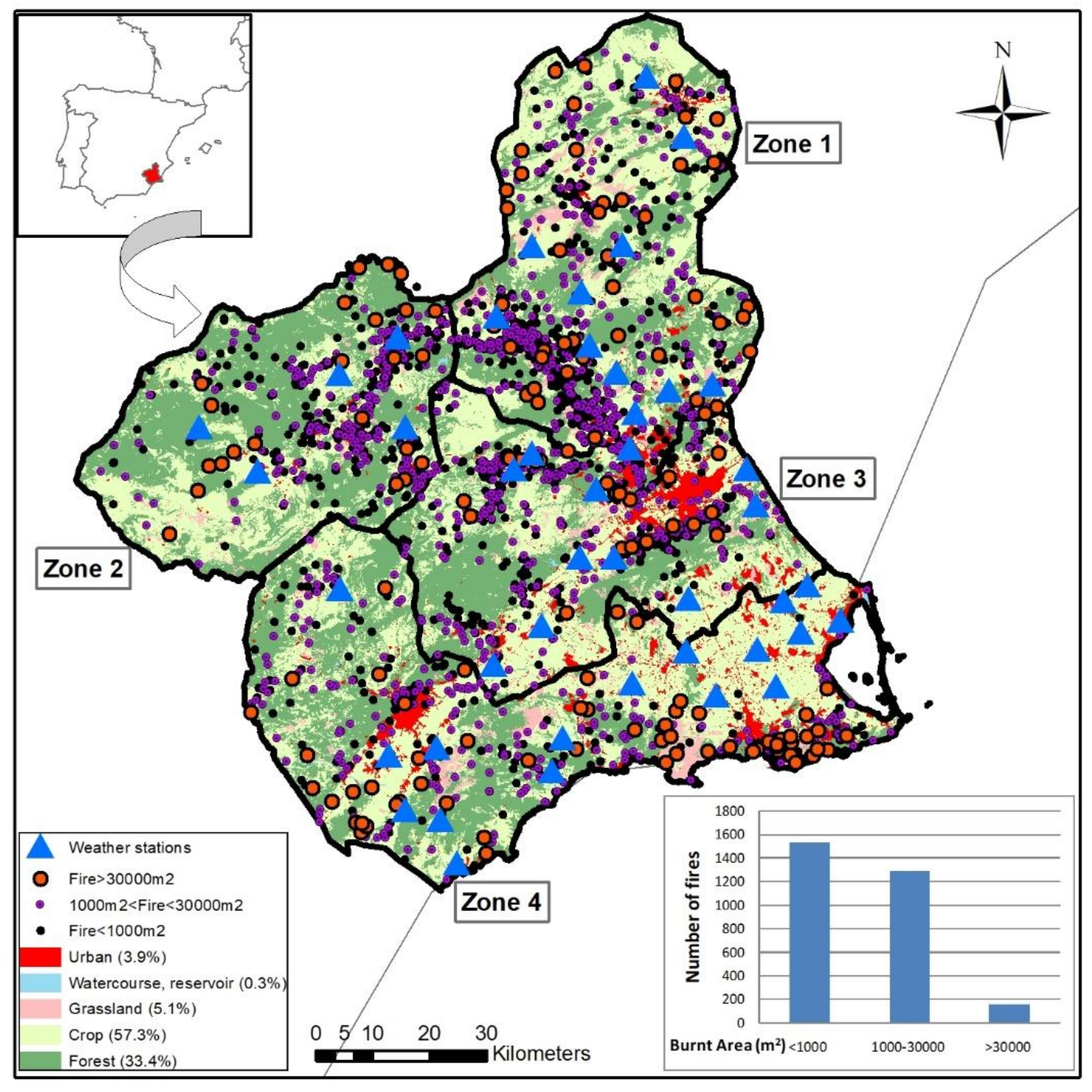
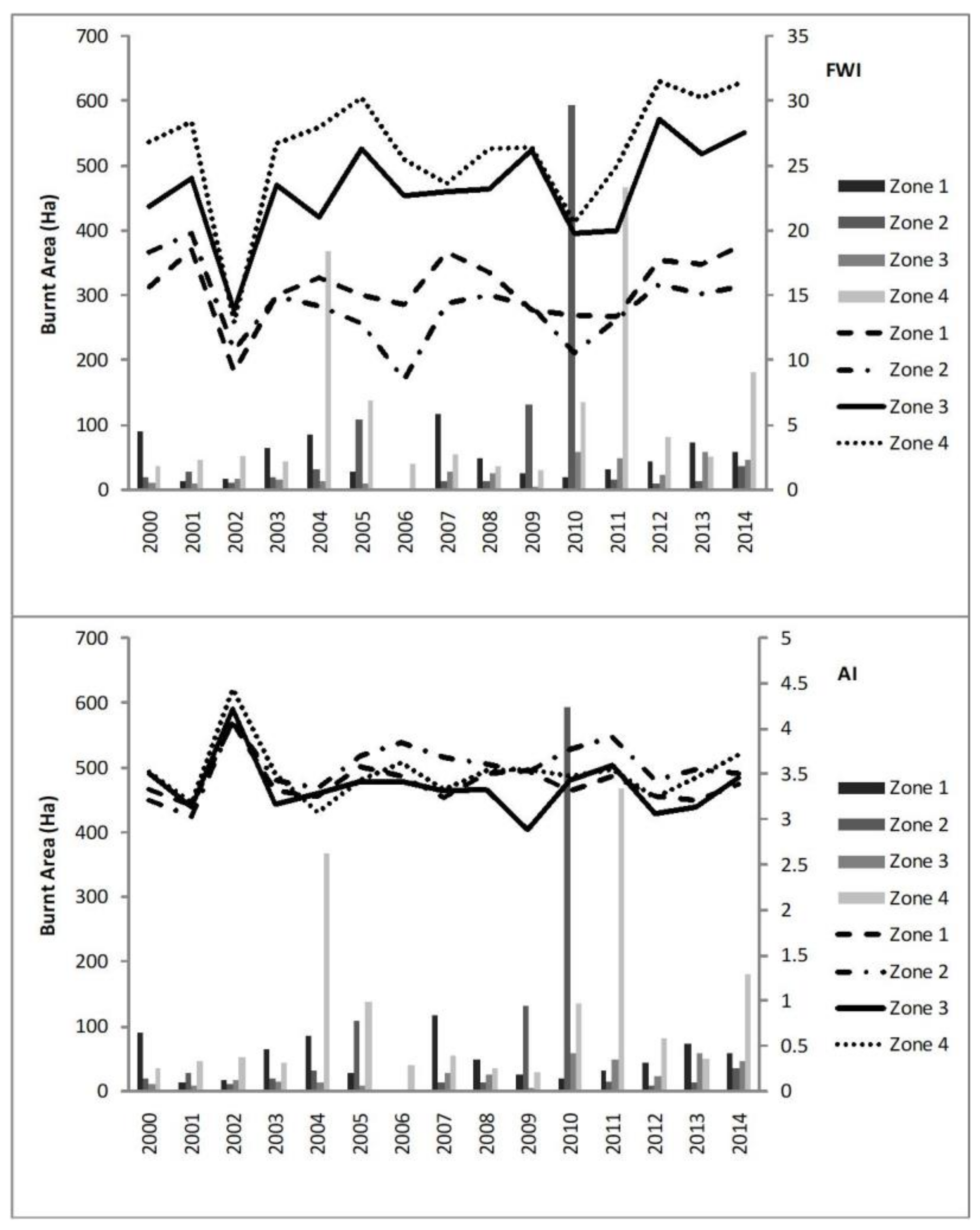

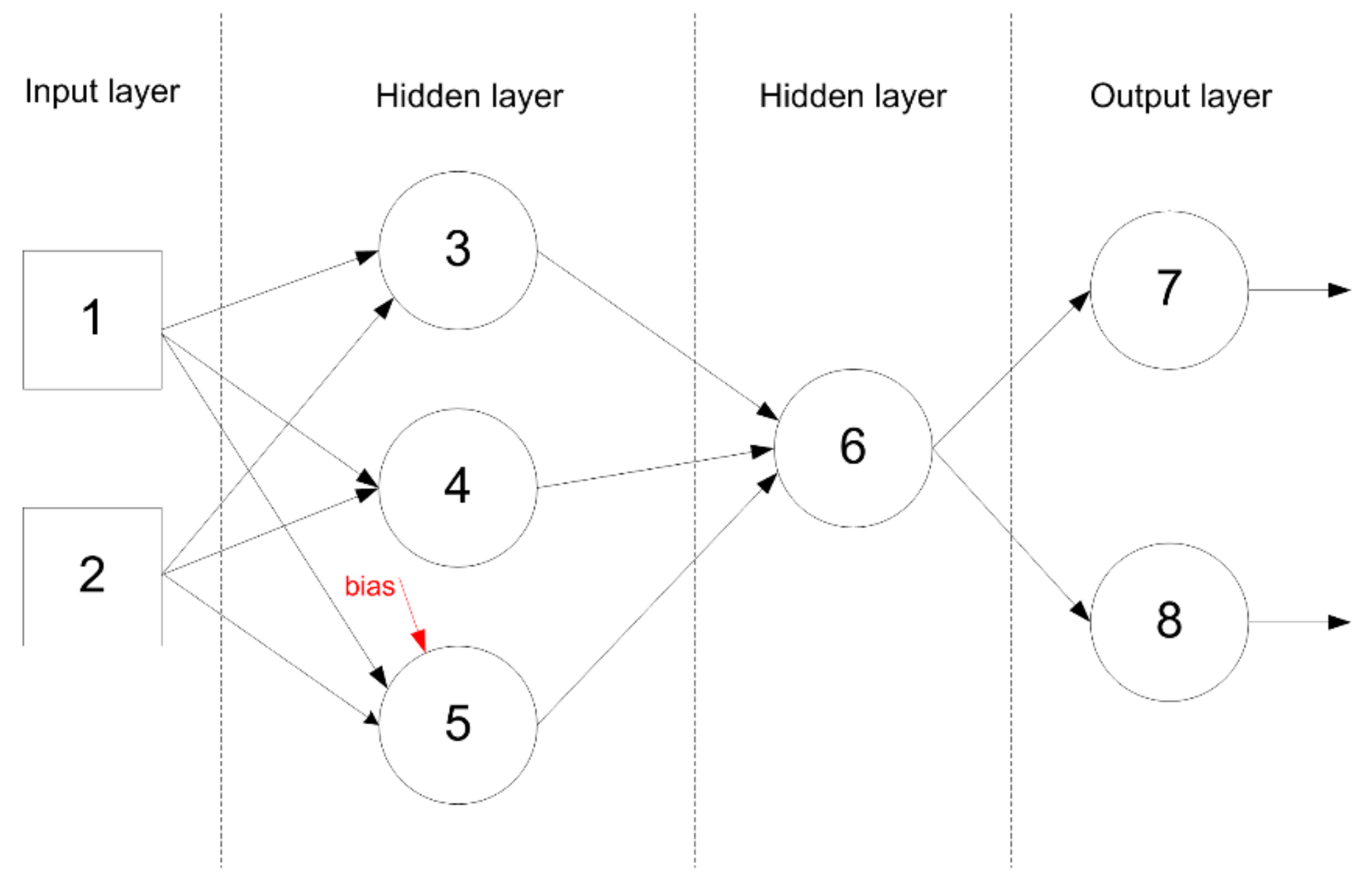
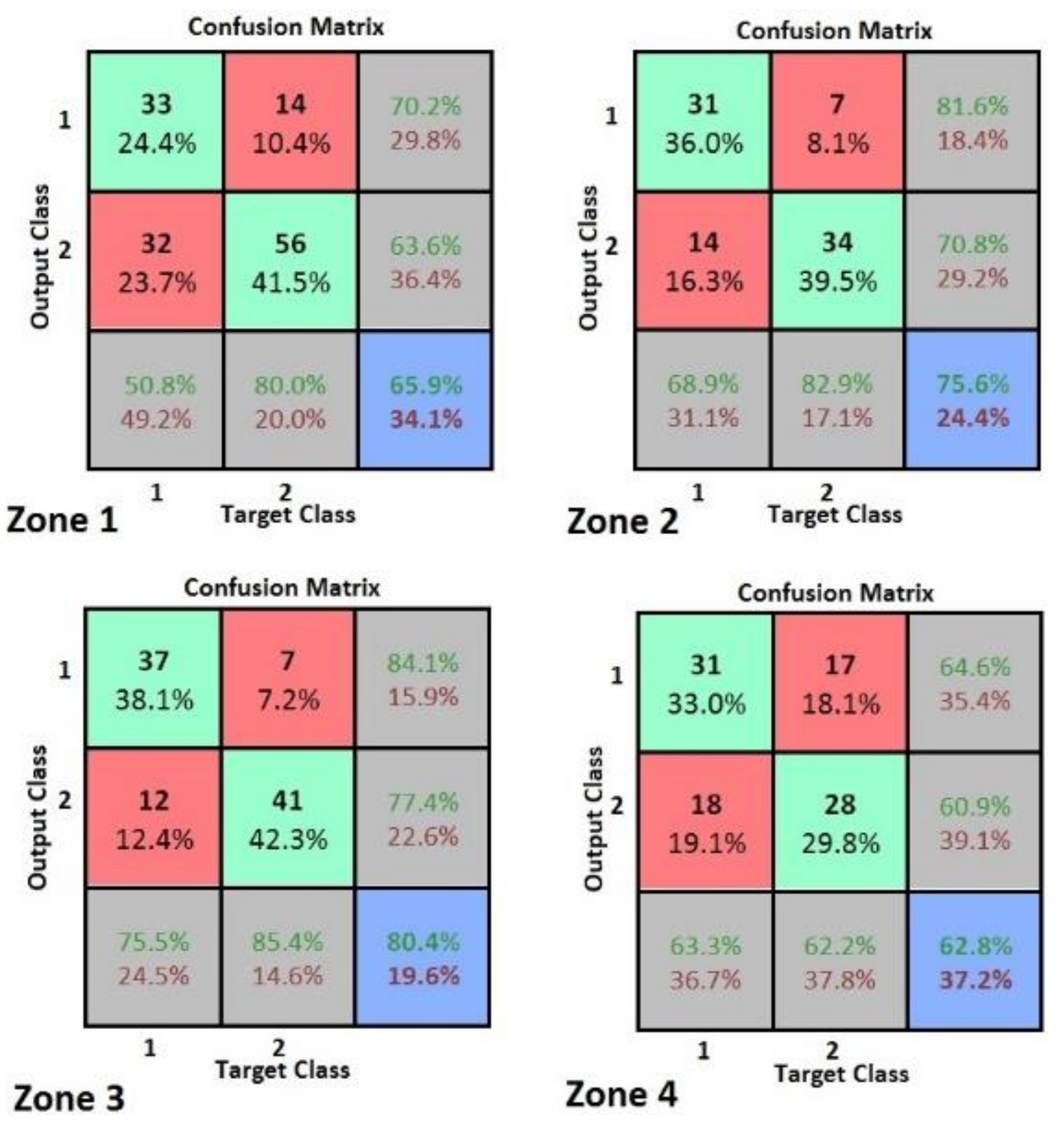
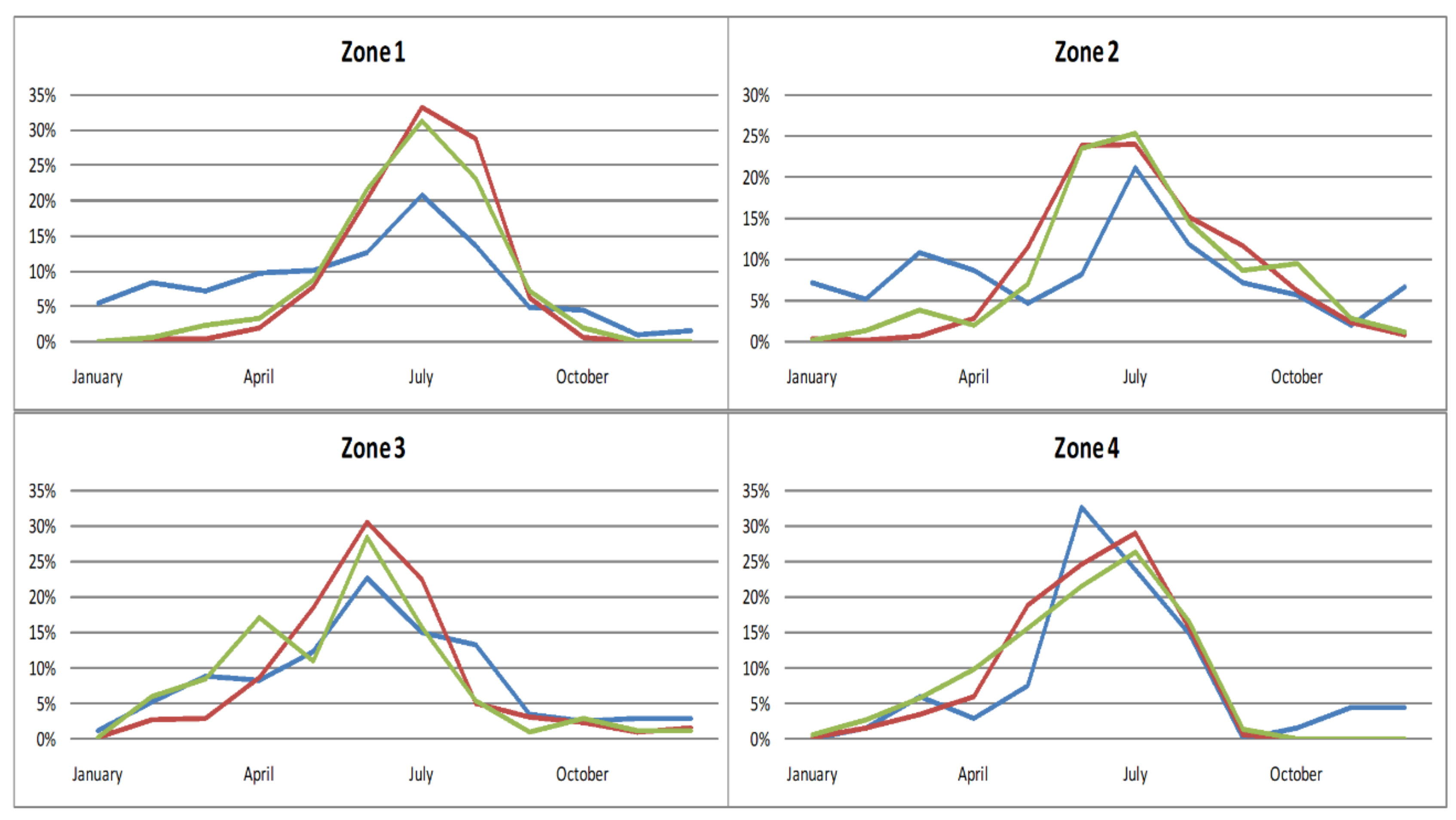
| Zone 1 | Zone 2 | Zone 3 | Zone 4 | ||
|---|---|---|---|---|---|
| Area (km2) | 2928.80 | 2378.50 | 2439.53 | 3564.96 | |
| Burned Surface Statistics (m2) | Mean | 6328 | 17,099 | 5634 | 32,300 |
| Max | 828,621 | 5,798,460 | 152,000 | 4,181,500 | |
| 50th percentile | 697 | 1000 | 1000 | 2160 | |
| 75th percentile | 3000 | 4000 | 5000 | 10,000 | |
| 95th percentile | 20,000 | 20,479 | 25,772 | 89,200 | |
| Number of fires | <1000 m2 | 676 | 315 | 334 | 210 |
| 1000 m2 < A < 30,000 m2 | 443 | 275 | 302 | 275 | |
| >30,000 m2 | 47 | 24 | 25 | 67 | |
| Total | 1166 | 614 | 661 | 552 | |
| Burned area (m2) | <1000 m2 | 203,078 | 99,926 | 88,076 | 67,090 |
| 1000 m2 < A < 30,000 m2 | 2,407,935 | 1,586,832 | 1,937,735 | 1,991,938 | |
| >30,000 m2 | 4,767,182 | 8,811,748 | 1,703,265 | 15,749,205 | |
| Total | 7,378,195 | 10,498,506 | 3,729,076 | 17,808,233 | |
| Variable | Description |
|---|---|
| X | x-axis coordinate UTM ETRS89 30N |
| Y | y-axis coordinate UTM ETRS89 30N |
| Z | Altitude (M.A.S.L.) |
| M | Month of the year (from 1 to 12) |
| Vegetation | Type of vegetation in the burned area (from 1 to 3: 1, grassland, 2, forest and 3, crop) |
| P | Daily Rainfall (mm) |
| H | Relative Humidity (%) |
| T | Average Temperature (°C) |
| V | Wind Speed (m/s) |
| FWI | Forest Weather Index |
| AI | Angströn Index |
| Zone 1 | Zone 2 | Zone 3 | Zone 4 | |
|---|---|---|---|---|
| k = 5 | 3080 | 4184 | 2107 | 8265 |
| 35,215 | 26,598 | 23,286 | 42,568 | |
| 95,782 | 152,483 | 57,714 | 241,028 | |
| 259,312 | 710,000 | 107,774 | 1,600,947 | |
| 455,400 | 992,100 | 152,000 | 4,181,500 | |
| k = 4 | 3655 | 4913 | 2352 | 17,169 |
| 29,588 | 37,144 | 27,893 | 37,852 | |
| 187,625 | 711,000 | 75,382 | 160,947 | |
| 455,400 | 99,200 | 131,032 | 4,181,500 | |
| k = 3 | 3655 | 4913 | 2397 | 10,258 |
| 31,026 | 43,526 | 30,280 | 27,169 | |
| 211,968 | 851,050 | 105,618 | 2,100,473 |
| Actual Class | Predicted Class | |
|---|---|---|
| Negative | Positive | |
| Negative | a | b |
| Positive | c | d |
| Zone | Period | Py (mm/year) | H (%) | T (°C) | V (m/s) |
|---|---|---|---|---|---|
| Zone 1 | 2000–2014 | 252.67 | 59.13 | 16.56 | 1.06 |
| 2071–2100 RCP4.5 | 350.67 | 57.96 | 18.09 | 1.24 | |
| 2071–2100 RCP8.5 | 328.92 | 56.79 | 20.04 | 1.21 | |
| Zone 2 | 2000–2014 | 341.42 | 61.08 | 15.84 | 1.96 |
| 2071–2100 RCP4.5 | 350.67 | 57.96 | 20.49 | 2.49 | |
| 2071–2100 RCP8.5 | 328.92 | 56.79 | 21.89 | 2.43 | |
| Zone 3 | 2000–2014 | 264.23 | 58.62 | 17.88 | 1.39 |
| 2071–2100 RCP4.5 | 350.67 | 57.96 | 19.54 | 1.75 | |
| 2071–2100 RCP8.5 | 328.92 | 56.79 | 21.29 | 1.69 | |
| Zone 4 | 2000–2014 | 214.06 | 65.87 | 18.57 | 1.79 |
| 2071–2100 RCP4.5 | 350.67 | 57.96 | 20.70 | 2.08 | |
| 2071–2100 RCP8.5 | 328.92 | 56.79 | 22.34 | 2.04 |
| Zone | Period | Total Number of Fires | Average Fires Per Year |
|---|---|---|---|
| Zone 1 | 2000–2014 | 661 | 44.03 |
| 2071–2100 RCP4.5 | 1981 | 66.00 | |
| 2071–2100 RCP8.5 | 2632 | 87.68 | |
| Zone 2 | 2000–2014 | 614 | 44.90 |
| 2071–2100 RCP4.5 | 2437 | 81.18 | |
| 2071–2100 RCP8.5 | 3170 | 105.60 | |
| Zone 3 | 2000–2014 | 1166 | 77.68 |
| 2071–2100 RCP4.5 | 2222 | 74.02 | |
| 2071–2100 RCP8.5 | 2933 | 97.70 | |
| Zone 4 | 2000–2014 | 552 | 36.77 |
| 2071–2100 RCP4.5 | 2396 | 79.82 | |
| 2071–2100 RCP8.5 | 3177 | 105.83 |
| Zone | Measure | 50–50% | 60–40% | 70–30% | 80–20% | 90–10% | Average |
|---|---|---|---|---|---|---|---|
| Zone 1 | Sensitivity (%) | 57.2 | 58.5 | 60.9 | 63.6 | 77.1 | 63.46 |
| Specificity (%) | 62.3 | 57.8 | 64.1 | 70.2 | 62.5 | 63.38 | |
| Accuracy (%) | 59.1 | 58.1 | 62.4 | 65.9 | 70.1 | 63.12 | |
| Zone 2 | Sensitivity (%) | 67.0 | 68.3 | 65.6 | 70.8 | 70.0 | 68.34 |
| Specificity (%) | 57.5 | 60.7 | 69.2 | 81.6 | 84.6 | 70.72 | |
| Accuracy (%) | 61.4 | 63.4 | 67.4 | 75.6 | 74.4 | 68.44 | |
| Zone 3 | Sensitivity (%) | 65.5 | 62.5 | 70.4 | 77.4 | 75.0 | 70.16 |
| Specificity (%) | 65.1 | 58.2 | 70.3 | 84.1 | 71.4 | 69.82 | |
| Accuracy (%) | 65.3 | 60.3 | 70.3 | 80.4 | 80.0 | 71.26 | |
| Zone 4 | Sensitivity (%) | 48.1 | 54.3 | 59.4 | 60.9 | 48.6 | 54.26 |
| Specificity (%) | 69.6 | 68.0 | 62.5 | 64.6 | 66.7 | 66.28 | |
| Accuracy (%) | 50.2 | 58.0 | 61.0 | 62.8 | 53.2 | 57.04 |
| Zone | K = 1 | K = 2 | K = 3 | K = 4 | K = 5 | K = 6 | K = 7 | K = 8 | K = 9 | K = 10 | Average | S.D. |
|---|---|---|---|---|---|---|---|---|---|---|---|---|
| Zone 1 | 67.6 | 53.7 | 67.2 | 63.2 | 70.6 | 53.7 | 58.8 | 52.2 | 62.7 | 65.7 | 61.54 | 6.58 |
| Zone 2 | 81.4 | 76.7 | 88.4 | 67.4 | 74.4 | 74.4 | 67.4 | 81.4 | 81.4 | 51.2 | 74.41 | 10.46 |
| Zone 3 | 72.9 | 66.7 | 79.6 | 66.7 | 69.4 | 62.5 | 63.3 | 71.4 | 56.3 | 83.3 | 69.21 | 8.06 |
| Zone 4 | 70.2 | 59.6 | 55.3 | 61.7 | 53.2 | 68.1 | 66 | 61.7 | 57.4 | 57.4 | 61.06 | 5.6 |
| Zone | Metric | Training | Validation | Test |
|---|---|---|---|---|
| Zone 1 | MAE (m2) | 40,882.33 | 22,644.32 | 39,377.21 |
| RMSE (m2) | 72,770.19 | 28,197.83 | 79,424.98 | |
| MAPE (%) | 32.54 | 34.10 | 25.88 | |
| Bias (m2) | 37,939.93 | 18,186.42 | –37,461.56 | |
| Zone 2 | MAE (m2) | 5643.24 | 6060.23 | 28,226.64 |
| RMSE (m2) | 7353.61 | 7087.41 | 34,996.43 | |
| MAPE (%) | 11.70 | 17.21 | 37.38 | |
| Bias (m2) | –2535.66 | –5702.80 | –21,409.82 | |
| Zone 3 | MAE (m2) | 5695.49 | 18,663.88 | 16,867.68 |
| RMSE (m2) | 9186.30 | 26,384.25 | 26,047.79 | |
| MAPE (%) | 11.83 | 28.20 | 18.83 | |
| Bias (m2) | 8.89 | 14,958.76 | –14,095.28 | |
| Zone 4 | MAE (m2) | 47,778.19 | 14,211.44 | 20,903.01 |
| RMSE (m2) | 65,997.94 | 17,194.42 | 25,914.53 | |
| MAPE (%) | 42.77 | 29.92 | 40.53 | |
| Bias (m2) | 29,474.66 | –4890.40 | 18,471.57 |
| Zone | Period | Total Burned Surface (km2) | Average Yearly Burned Surface (km2) | Increase of Total Burned Surface (%) |
|---|---|---|---|---|
| Zone 1 | 2000–2014 | 4.77 | 0.32 | - |
| 2071–2100 RCP4.5 | 60.99 | 2.03 | 534 | |
| 2071–2100 RCP8.5 | 85.95 | 2.86 | 259 | |
| Zone 2 | 2000–2014 | 8.81 | 0.59 | - |
| 2071–2100 RCP4.5 | 40.66 | 1.36 | 131 | |
| 2071–2100 RCP8.5 | 54.08 | 1.80 | 205 | |
| Zone 3 | 2000–2014 | 1.70 | 0.11 | - |
| 2071–2100 RCP4.5 | 37.01 | 1.23 | 1018 | |
| 2071–2100 RCP8.5 | 53.46 | 1.78 | 1518 | |
| Zone 4 | 2000–2014 | 15.75 | 1.05 | - |
| 2071–2100 RCP4.5 | 118.23 | 3.94 | 275 | |
| 2071–2100 RCP8.5 | 154.05 | 5.14 | 390 |
© 2019 by the authors. Licensee MDPI, Basel, Switzerland. This article is an open access article distributed under the terms and conditions of the Creative Commons Attribution (CC BY) license (http://creativecommons.org/licenses/by/4.0/).
Share and Cite
Pérez-Sánchez, J.; Jimeno-Sáez, P.; Senent-Aparicio, J.; Díaz-Palmero, J.M.; Cabezas-Cerezo, J.d.D. Evolution of Burned Area in Forest Fires under Climate Change Conditions in Southern Spain Using ANN. Appl. Sci. 2019, 9, 4155. https://doi.org/10.3390/app9194155
Pérez-Sánchez J, Jimeno-Sáez P, Senent-Aparicio J, Díaz-Palmero JM, Cabezas-Cerezo JdD. Evolution of Burned Area in Forest Fires under Climate Change Conditions in Southern Spain Using ANN. Applied Sciences. 2019; 9(19):4155. https://doi.org/10.3390/app9194155
Chicago/Turabian StylePérez-Sánchez, Julio, Patricia Jimeno-Sáez, Javier Senent-Aparicio, José María Díaz-Palmero, and Juan de Dios Cabezas-Cerezo. 2019. "Evolution of Burned Area in Forest Fires under Climate Change Conditions in Southern Spain Using ANN" Applied Sciences 9, no. 19: 4155. https://doi.org/10.3390/app9194155
APA StylePérez-Sánchez, J., Jimeno-Sáez, P., Senent-Aparicio, J., Díaz-Palmero, J. M., & Cabezas-Cerezo, J. d. D. (2019). Evolution of Burned Area in Forest Fires under Climate Change Conditions in Southern Spain Using ANN. Applied Sciences, 9(19), 4155. https://doi.org/10.3390/app9194155







